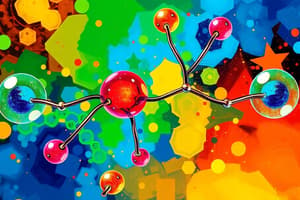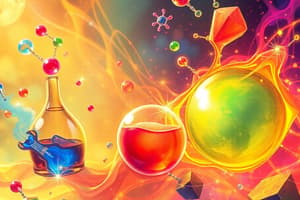Podcast
Questions and Answers
What is the consequence of too much potassium outside nerve cells?
What is the consequence of too much potassium outside nerve cells?
- Electrical impulses become stronger.
- Electrical impulses cause muscle contractions.
- Electrical impulses die away. (correct)
- Electrical impulses are unaffected.
What is a potential effect of a potassium overdose?
What is a potential effect of a potassium overdose?
- Enhanced cognitive functions.
- Decreased heart rate.
- Increased muscle function.
- Convulsions. (correct)
Which electrolyte relationship is correctly matched?
Which electrolyte relationship is correctly matched?
- Hypernatremia - deficiency of sodium.
- Hypokalemia - excessive potassium.
- Hyponatremia - excess sodium.
- Hyperkalemia - excessive potassium. (correct)
Which statement distinguishes electrolytes from non-electrolytes?
Which statement distinguishes electrolytes from non-electrolytes?
What is the primary cationic electrolyte found inside cells?
What is the primary cationic electrolyte found inside cells?
What is the primary feature of the octet rule?
What is the primary feature of the octet rule?
Which type of bond is characterized by the unequal sharing of electrons?
Which type of bond is characterized by the unequal sharing of electrons?
Which statement correctly describes an electrolyte?
Which statement correctly describes an electrolyte?
What is the main consequence of hyperkalemia?
What is the main consequence of hyperkalemia?
How can you predict whether a polar covalent bond will form?
How can you predict whether a polar covalent bond will form?
What is an example of a principal electrolyte in body fluids?
What is an example of a principal electrolyte in body fluids?
Which of the following statements is true about ionic bonding?
Which of the following statements is true about ionic bonding?
What determines the effectiveness of an electrolyte?
What determines the effectiveness of an electrolyte?
What type of bond is formed when the difference in electronegativity is greater than 2.0?
What type of bond is formed when the difference in electronegativity is greater than 2.0?
What is the formula to calculate an equivalent of a substance?
What is the formula to calculate an equivalent of a substance?
Which of the following statements about pure covalent bonds is true?
Which of the following statements about pure covalent bonds is true?
What is the electronegativity difference for a polar covalent bond?
What is the electronegativity difference for a polar covalent bond?
How many milliequivalents (mEq) are in one equivalent (Eq)?
How many milliequivalents (mEq) are in one equivalent (Eq)?
What does the suffix '-emia' indicate in medical terminology?
What does the suffix '-emia' indicate in medical terminology?
In the bond between sodium and chlorine, what is the resulting ion for sodium after it loses an electron?
In the bond between sodium and chlorine, what is the resulting ion for sodium after it loses an electron?
What potential outcome can result from hypokalemia?
What potential outcome can result from hypokalemia?
What characterizes the ionic bond formed between lithium and fluorine?
What characterizes the ionic bond formed between lithium and fluorine?
Which of the following compounds typically forms pure covalent bonds?
Which of the following compounds typically forms pure covalent bonds?
Which of the following best describes the term '-hypo' in the context of electrolyte disorders?
Which of the following best describes the term '-hypo' in the context of electrolyte disorders?
Which element has the highest electronegativity in the provided content?
Which element has the highest electronegativity in the provided content?
What percentage more potassium than sodium is found in the human body according to the content?
What percentage more potassium than sodium is found in the human body according to the content?
What is the role of K+ and Na+ ions in nerve cell membranes?
What is the role of K+ and Na+ ions in nerve cell membranes?
What type of bond is formed in water (H2O)?
What type of bond is formed in water (H2O)?
What condition can result from a diet low in potassium?
What condition can result from a diet low in potassium?
What is the electron configuration of the calcium ion [Ca]2+?
What is the electron configuration of the calcium ion [Ca]2+?
What type of interaction occurs between metal and non-metal atoms in ionic compounds?
What type of interaction occurs between metal and non-metal atoms in ionic compounds?
Which of the following describes a characteristic of electrolytes?
Which of the following describes a characteristic of electrolytes?
Which of the following ions is commonly found in blood as an electrolyte?
Which of the following ions is commonly found in blood as an electrolyte?
What is the role of hydration spheres in aqueous solutions of ions?
What is the role of hydration spheres in aqueous solutions of ions?
What characterizes an ionic bond?
What characterizes an ionic bond?
What characteristic property does water possess due to the difference in electronegativity between hydrogen and oxygen?
What characteristic property does water possess due to the difference in electronegativity between hydrogen and oxygen?
Which of the following statements about ionic compounds is true?
Which of the following statements about ionic compounds is true?
How do covalent bonds differ from ionic bonds?
How do covalent bonds differ from ionic bonds?
Which of the following ions is considered a weak electrolyte?
Which of the following ions is considered a weak electrolyte?
What role does electronegativity play in chemical bonding?
What role does electronegativity play in chemical bonding?
What typically happens when two atoms with widely different electronegativity values interact?
What typically happens when two atoms with widely different electronegativity values interact?
In a polar covalent bond, what can be inferred about the participating atoms?
In a polar covalent bond, what can be inferred about the participating atoms?
What occurs in a non-polar covalent bond?
What occurs in a non-polar covalent bond?
Which statement is true about electronegativity trends?
Which statement is true about electronegativity trends?
Why do ionic compounds generally form between elements with high electronegativity differences?
Why do ionic compounds generally form between elements with high electronegativity differences?
Flashcards
Ionic Bond
Ionic Bond
An electrostatic force that holds cations and anions together in a compound.
Covalent Bond
Covalent Bond
A bond formed when atoms share one pair of electrons.
Electronegativity
Electronegativity
An atom's ability to attract electrons in a chemical bond.
Non-polar Covalent Bond
Non-polar Covalent Bond
Signup and view all the flashcards
Polar Covalent Bond
Polar Covalent Bond
Signup and view all the flashcards
Ionic compound formation
Ionic compound formation
Signup and view all the flashcards
Cation
Cation
Signup and view all the flashcards
Anion
Anion
Signup and view all the flashcards
Octet Rule
Octet Rule
Signup and view all the flashcards
Noble gas configuration
Noble gas configuration
Signup and view all the flashcards
Electrolyte
Electrolyte
Signup and view all the flashcards
Body Fluid Electrolytes
Body Fluid Electrolytes
Signup and view all the flashcards
Pure Covalent Bond
Pure Covalent Bond
Signup and view all the flashcards
Difference in Electronegativity
Difference in Electronegativity
Signup and view all the flashcards
Nonmetals
Nonmetals
Signup and view all the flashcards
Alkali and Alkaline Earth Metals
Alkali and Alkaline Earth Metals
Signup and view all the flashcards
Ionic Character
Ionic Character
Signup and view all the flashcards
Ionic Bond Formation
Ionic Bond Formation
Signup and view all the flashcards
Strong Electrolyte
Strong Electrolyte
Signup and view all the flashcards
Water Dipole
Water Dipole
Signup and view all the flashcards
Hydration Sphere
Hydration Sphere
Signup and view all the flashcards
Electrolytes in Body
Electrolytes in Body
Signup and view all the flashcards
Ionic Compound Properties
Ionic Compound Properties
Signup and view all the flashcards
Equivalent
Equivalent
Signup and view all the flashcards
Equivalents and charge
Equivalents and charge
Signup and view all the flashcards
Electrolyte status
Electrolyte status
Signup and view all the flashcards
Milliequivalents per liter (mEq/L)
Milliequivalents per liter (mEq/L)
Signup and view all the flashcards
Hypokalemia
Hypokalemia
Signup and view all the flashcards
Role of potassium in nerve function
Role of potassium in nerve function
Signup and view all the flashcards
Hypernatremia
Hypernatremia
Signup and view all the flashcards
LoSalt
LoSalt
Signup and view all the flashcards
Potassium's role in nerve cells
Potassium's role in nerve cells
Signup and view all the flashcards
Electrolyte overload: Potassium
Electrolyte overload: Potassium
Signup and view all the flashcards
Electrolyte deficiency: Potassium
Electrolyte deficiency: Potassium
Signup and view all the flashcards
Electrolytes in body fluids
Electrolytes in body fluids
Signup and view all the flashcards
Electrolyte concentration (mEq/L)
Electrolyte concentration (mEq/L)
Signup and view all the flashcards
Study Notes
Fundamentals of Medicinal and Pharmaceutical Chemistry
- Topic: Ionic Bonding and Electrolyte Status of Body Fluid
- Course: FUNCHEM.6
- Lecturer: Dr. Darren Griffith
- Reading Recommendation: Chang and Goldsby 7e, Section 9.1, 9.2, 9.4, 9.5
Learning Outcomes
- Define 'octet rule' and recall 'electronegativity'.
- Differentiate between 'pure covalent' and 'polar covalent' bonding.
- Explain 'ionic bonding' and 'ionic character'.
- Predict covalent, polar covalent, or ionic bonding based on electronegativity values.
- Explain the formation of ionic compounds using electronic configurations.
- Differentiate between 'electrolytes' and 'non-electrolytes'.
- Recall principal electrolytes in body fluids.
- Solve calculations regarding electrolyte concentrations in mEq/L.
- Explain the importance of electrolytes in the body.
- Explain consequences of electrolyte overload or deficiencies (e.g., hypo/hyperkalemia and hypo/hypernatremia).
Noble Gas Configuration
- Noble gases are chemically stable (inert).
- They share a common electron configuration of 8 valence electrons.
- Helium (He) is an exception, with 2 valence electrons.
Octet Rule
- Atoms other than hydrogen tend to form bonds until they are surrounded by 8 valence electrons.
- Atoms are most stable with a filled or empty outer electron shell.
- Atoms will gain or lose electrons (ionic) or share electrons (covalent) to achieve a noble gas configuration.
Chemical Bonds
- Ionic Bond: The electrostatic force holding cations and anions in an ionic compound.
- Atoms either completely lose (cations) or gain (anions) electrons to become charged.
- Watch the VLE animation 'Ionic vs Covalent Bonding'.
Chemical Bonds - Covalent
- A covalent bond forms when atoms share one pair of electrons.
- Neither atom is willing to give up or take away an electron.
- Watch the VLE animation titled "Ionic vs Covalent Bonding".
Ionic vs Covalent
- Electronegativity of individual atoms influences ionic or covalent bond formation.
- High electronegativity difference leads to ionic bonds.
- Low electronegativity difference leads to covalent bonds.
- Electronegativity is an atom's ability to attract electrons in a chemical bond.
Electronegativity
- The ability of an atom in a molecule to attract electrons in a chemical bond.
- Similar electronegativity leads to equal sharing of electrons (non-polar).
- Different electronegativity leads to unequal sharing (polar covalent bond or complete transfer in ionic bond).
Electronegativity Trends
- Electronegativity generally increases across a period and decreases down a group.
- The most electronegative elements are nonmetals.
- The least electronegative elements are alkali and alkaline-earth metals.
Types of Chemical Bonds
- Ionic: Wide difference in electronegativity (>2.0)
- Polar Covalent: Moderate difference in electronegativity (0.3 - 2.0).
- Pure Covalent: Virtually no difference in electronegativity (= 0).
Ionic and Ionic Character
- The greater the difference in electronegativity, the greater the ionic character.
- For example: LiF has higher ionic character than HCI.
Some Salts for Practice
- Examples of ionic compounds (NaCl, CaO) illustrate electron transfer for stability.
Calcium and Oxygen
- Calcium and oxygen form a stable ionic compound with calcium ions losing 2 electrons to achieve stable configurations.
Properties of Ionic Compounds
- Ionic compounds often form crystal lattices due to electrostatic forces.
- They generally have high melting points and are soluble in water.
Electrolytes - Ions in Solution
- Electrolytes dissolve in water, separating into charged particles (ions).
- Ions are hydrated (surrounded by water molecules) in aqueous solutions.
- Strong electrolytes separate completely, weak electrolytes partially.
- Nonelectrolytes do not conduct electricity.
Water - Dipole
- Water is a polar molecule due to unequal sharing of electrons.
- It forms a dipole moment with partial positive charge on hydrogen and partial negative charge on oxygen.
Electrolytes in the Body
- Electrolytes (e.g., Na+, K+, Ca2+, Mg2+, etc.) are found in various body fluids (blood, cells, interstitial fluid).
- Common representation of electrolytes in clinical settings is milliequivalents per litre (mEq/L).
Equivalents
- An equivalent of a substance represents an amount of material that can react or combine with an Avogadro's number of charges.
- It depends on the charge or valence of the ion.
In Clinical Situations
- Electrolyte status is measured (blood plasma/serum).
- Results are often reported as mEq/L.
Importance of Electrolytes
- Changes in sodium and potassium concentrations can lead to serious medical emergencies.
- Terms related to electrolyte problems often include "-emia" and can be "hypo" or "hyper" for low or high concentration, respectively (e.g., hypokalemia, hypernatremia).
Nervous System and Electrolytes
- Ions like K+ and Na+ play critical roles in nerve cell function and electrical signals.
- Imbalances can lead to severe consequences.
LoSalt - Essential and Deadly
- Potassium (K+) is more prevalent in the body than sodium (Na+).
- Potassium is crucial for cellular function, particularly in nerve and muscle tissues.
- High potassium levels can be lethal.
Deadly KCl
- Excessive potassium outside nerve cells disrupts electrical signals.
- High intake can cause neurological problems, cardiac arrest, and death.
Learning Outcomes (Summary)
- Define octet rule, valence, and electronegativity.
- Explain and differentiate between covalent bonding types.
- Differentiate electrolytes and non-electrolytes.
- Explain electrolyte concentrations (mEq/L).
- Describe the importance of electrolytes in body function and the consequences of imbalances.
Studying That Suits You
Use AI to generate personalized quizzes and flashcards to suit your learning preferences.
Related Documents
Description
This quiz covers essential concepts related to electrolytes, their effects, and types of chemical bonds. It includes questions on potassium levels, bonding characteristics, and the octet rule. Test your knowledge on these fundamental biochemistry topics to see how well you understand the role of electrolytes in biological systems.




